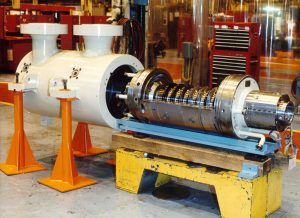Compressor throughput control

Picture courtesy Siemens (Dresser-Rand)[/caption]
A constant speed electric motor driven compressor, controlled by a suction throttle valve, provides a simple solution. The startup controls are relatively straightforward and there is no warm-up sequence, as might be needed in a steam turbine. No over speed protection is needed. However, the cost of electricity can be relatively high and throttling inherently wastes energy. Therefore, constant speed electric motor driven compressors with throttling used for control are not necessarily the most energy efficient, but are simple to start and operate.
This article contains excerpts from the paper, “Development and design of antisurge and performance control systems for centrifugal compressors” by Saul Mirsky, Wayne Jacobson, David Tiscornia, Jeff McWhirter and Medhat Zaghloul of Compressor Controls Corporation at the 2015 Middle East Turbomachinery Symposium.
A constant speed electric motor driven compressor, controlled by a discharge throttle valve, has similar characteristics to that of a suction throttle. Both are relatively easy to operate and maintain. However, for an equivalent reduction in throughput, suction throttling uses less power because the inlet gas density is reduced. Additionally, discharge throttling has substantially stronger negative effect on the antisurge control then the suction throttling. Therefore suction throttling is recommended over discharge throttling as a compressor throughput control method. Constant speed compressors controlled by inlet guide vanes are more complicated than suction throttle machines, but are also more efficient. Inlet guide vanes effectively change the compressor performance characteristics at each vane angle. Therefore as the guide vanes open, not only does the flow increase but the performance curve steepness and surge flow changes as well.
Applications using turbine driven compressors are usually more efficient than throttled compressors because of the losses associated with throttling. The machine speed is varied until the flow requirement at a given pressure ratio is met. However, turbines (gas or steam) require complicated start-up and warm-up sequences. Over speed protection controls are also required on turbines.
Variable frequency drives (VFD) provide an efficient means for starting and controlling the speed of an electric motor. As technology improves, such drives have gained in popularity. Grounding and harmonic vibrations are some of the main issues associated with VFD’s. Electric motors can also vary the drive speed through a fluid coupling.
Guide vanes are used in the fluid coupling to control the amount of transmitted torque. By varying the torque to the compressor shaft, speed can be controlled. Closed loop speed control greatly improves the response time and accuracy of this throughput method. Absence of speed control leads to the compressor operating at fluctuating speeds as the load changes, and thus results in poorer quality of throughput control and possibly a negative impact on the capability of the antisurge control to protect the compressor. Drawbacks of this approach are loss of efficiency and increased machine complexity.